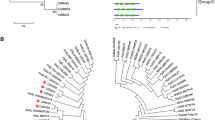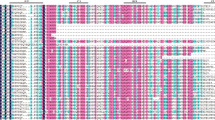Abstract
Three partial S-RNase genes, MSRN-1, MSRN-2, and MSRN-3, in the Japanese apricot (Prunus mume Sieb. et Zucc.) were isolated from the three cultivars Nankou, Gyokuei, and Kairyouuchidaume, respectively. The structural characteristics revealed that S-RNase genes from the Japanese apricot were in the T2/SRNase-type S-RNase family with five conserved regions (C1, C2, C3, RC4, and C5) and one variable region (RHV) as reported in the other rosaceous plants. In the phylogenetic tree of T2/S SRNase-type RNases, three S-RNase genes of the Japanese apricot did not form a species-specific subgroup but the Prunus subfamily did. At least seven S-allelic genes were present in the Japanese apricot, and S-genotypes of six representative cultivars, including Nankou, Gyokuei, Kairyouuchidaume, Baigou, Kagajizou, and Oushuku were first established in this study as S 1 S 7, S 2 S 6, S 3 S 4, S 3 S 6, S 3 S 6 and S 1 S 5, respectively. An extended elucidation of the S-genotype would contribute to a more efficient breeding program of the Japanese apricot.
Similar content being viewed by others
Author information
Authors and Affiliations
Additional information
Received: 5 September 2000 / Revision accepted: 22 December 2000
Rights and permissions
About this article
Cite this article
Yaegaki, H., Shimada, T., Moriguchi, T. et al. Molecular characterization of S-RNase genes and S-genotypes in the Japanese apricot (Prunus mume Sieb. et Zucc.). Sex Plant Reprod 13, 251–257 (2001). https://doi.org/10.1007/s004970100064
Issue Date:
DOI: https://doi.org/10.1007/s004970100064




